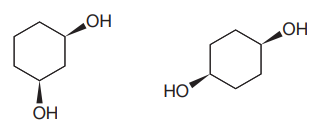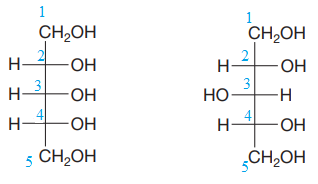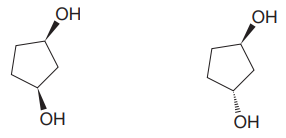
Concept explainers
(a)
Interpretation:
Whether the compounds in the given pair have the same or different boiling points is to be determined.
Concept introduction:
Isomers are the pair of compounds that have the same formula.
Constitutional isomers are the isomers having the same molecular formula but different connectivity. Constitutional isomers must have different physical and chemical properties.
The configurational isomers are not interconvertible by rotating around a single bond.
Enantiomers are configurational isomers having the same connectivity but cannot be interconvertible by rotation around a single bond. The mirror images of enantiomers are non-superimposable. Since enantiomers have the same connectivity of atoms, they should behave identically.
Diastereomers are configurational isomers having same connectivity but are not mirror images of each other. Diastereomers show different physical and chemical properties. Cis-trans isomers are diastereomers.
The boiling point of isomers comes under physical property.
Answer to Problem 5.53P
The given pair of isomers have different boiling points as they are diastereomers of each other.
Explanation of Solution
The given pair of compounds is


Both the molecules in the given pair have the same molecular formula; they also have the same connectivity. Thus, they are configurational isomers. The given pair of molecules is cis-trans isomers. So, these compounds are diastereomers of each other. Diastereomers show different physical and chemical properties. Thus, the compounds in the given pair should have different boiling points.
The given pair of isomers have different boiling point as they are diastereomers of each other.
(b)
Interpretation:
Whether the compounds in the given pair have the same or different boiling points is to be determined.
Concept introduction:
Isomers are the pair of compounds that have the same formula.
Constitutional isomers are the isomers having the same molecular formula but different connectivity. Constitutional isomers must have different physical and chemical properties.
The configurational isomers are not interconvertible by rotating around a single bond.
Enantiomers are configurational isomers having the same connectivity but cannot be interconvertible by rotation around a single bond. The mirror images of enantiomers are non-superimposable. Since enantiomers have the same connectivity of atoms, they should behave identically.
Diastereomers are configurational isomers that have the same connectivity but are not mirror images of each other. Diastereomers have different physical and chemical properties. Cis-trans isomers are diastereomers of each other.
The boiling point of isomers comes under physical property.
Answer to Problem 5.53P
The given pair of isomers have different boiling points as they are constitutional isomers of each other.
Explanation of Solution
The given pair of compounds is

Both the molecules in the given pair have the same molecular formula, so they are isomers.
However, they do not have same connectivity of atoms. In both the compounds, there are two
In the first compound, the
The given pair of isomers have different boiling points as they are constitutional isomers of each other.
(c)
Interpretation:
Whether the compounds in the given pair have the same or different boiling points is to be determined.
Concept introduction:
Isomers are the pair of compounds that have the same formula.
Constitutional isomers are the isomers having the same molecular formula but different connectivity. Constitutional isomers must have different physical and chemical properties.
The configurational isomers are not interconvertible by rotating around a single bond.
Enantiomers are configurational isomers having the same connectivity but cannot be interconvertible by rotation around a single bond. The mirror images of enantiomers are non-superimposable. Since enantiomers have the same connectivity of atoms, they should behave identically.
Diastereomers are configurational isomers that have the same connectivity but are not mirror images of each other. Diastereomers have different physical and chemical properties. Cis-trans isomers are diastereomers of each other.
The boiling point of isomers comes under physical property.
In a Fischer projection, exchanging two groups on an asymmetric carbon atoms gives the opposite stereochemical configuration.
Answer to Problem 5.53P
The given pair of isomers should have different boiling points as they are diastereomers of each other.
Explanation of Solution
The given pair of compounds is

Both the molecules in the given pair have the same molecular formula. They also have the same connectivity. Thus, they are configurational isomers.
Each molecule has three chiral centers at C2, C3, and C4 carbon atoms. Note that in the second compound, the two groups on C3 chiral carbon have been exchanged. This suggests that the stereochemical configurations at C3 carbon atoms in both the compounds are opposite to each other. Remaining stereo centers have the same stereochemical configuration, suggesting that the two compounds are diastereomers of each other. Diastereomers have different physical and chemical properties. Thus, the compounds in the given pair should have different boiling points.
The given pair of isomers have different boiling points as they are diastereomers of each other.
(d)
Interpretation:
Whether the compounds in the given pair have the same or different boiling points is to be determined.
Concept introduction:
Isomers are the pair of compounds that have the same formula.
Constitutional isomers are the isomers having the same molecular formula but different connectivity. Constitutional isomers must have different physical and chemical properties.
The configurational isomers are not interconvertible by rotating around a single bond.
Enantiomers are configurational isomers having the same connectivity but cannot be interconvertible by rotation around a single bond. The mirror images of enantiomers are non-superimposable. Since enantiomers have the same connectivity of atoms, they should behave identically.
Diastereomers are configurational isomers that have the same connectivity but are not mirror images of each other. Diastereomers have different physical and chemical properties. Cis-trans isomers are diastereomers of each other. Cyclic
The boiling point of isomers comes under physical property.
Answer to Problem 5.53P
The given pair of isomers should have different boiling points as they are diastereomers of each other.
Explanation of Solution
The given pair of compounds is

In both the compounds, the
The given pair of isomers have different boiling points as they are diastereomers of each other.
(e)
Interpretation:
Whether the compounds in the given pair have the same or different boiling points is to be determined.
Concept introduction:
Isomers are the pair of compounds that have the same formula.
Constitutional isomers are the isomers having the same molecular formula but different connectivity. Constitutional isomers must have different physical and chemical properties.
The configurational isomers are not interconvertible by rotating around a single bond.
Enantiomers are configurational isomers having the same connectivity but cannot be interconvertible by rotation around a single bond. The mirror images of enantiomers are non-superimposable. Since enantiomers have the same connectivity of atoms, they should behave identically.
The boiling point of isomers comes under physical property.
Answer to Problem 5.53P
The given pair of isomers should have the same boiling point as they are enantiomers of each other.
Explanation of Solution
The given pair of compounds is

In both the compounds, the
The stereochemical configuration at the chiral center in the first molecule is S as the top-three priority groups are arranged in a counterclockwise manner, and the fourth-priority group is on a dash bond.
The stereochemical configuration at the chiral center in the second molecule is R as the top-three priority groups are arranged in a counterclockwise manner, but the fourth-priority group is on a wedge bond.
Thus, the stereochemical configuration at the chiral centers for two molecules is opposite. This indicates that the two compounds must be enantiomers of each other. Enantiomers have precisely the same physical and chemical properties. Hence the two compounds in the given pair have the same boiling points.
The given pair of isomers should have the same boiling point as they are enantiomers of each other.
Want to see more full solutions like this?
Chapter 5 Solutions
Organic Chemistry: Principles And Mechanisms: Study Guide/solutions Manual (second)
- ● Biological Macromolecules Naming and drawing cyclic monosaccharides Your answer is incorrect. • Row 1: Your answer is incorrect. Row 3: Your answer is incorrect. • Row 4: Your answer is incorrect. Try again... 0/5 Give the complete common name, including anomer and stereochemistry labels, of the following molecules. You will find helpful information in the ALEKS resource. CH2OH OH OH H H I H OH OH H] H CH2OH H OH ẞ-L-sorbose HOCH2 OH OH H HOCH2 H OH OH H OH H H CH2OH OH H H OH H I- H OH H OH Explanation Recheck W E R % 25 α B Y X & 5 D F G H McGraw Hill LLC. All Rights Reserved. Terms of Use | Pr Parrow_forwardWhat is the missing reactant in this organic reaction? + R -A HO IN + H₂O Specifically, in the drawing area below draw the skeletal ("line") structure of R. If there is more than one reasonable answer, you can draw any one of them. If there is no reasonable answer, check the No answer box under the drawing area. Note for advanced students: you may assume no products other than those shown above are formed. Explanation Check Click and drag to start drawing a structure. © 2025 McGraw Hill LLC. All Rights Reserved. Terms of Use | Privacy Centerarrow_forwardStuc X ctclix ALE X A ALE אן A ALEX Lab (195 X Nut x M Inb x NU X NUT X Unt x + → C www-awu.aleks.com/alekscgi/x/Isl.exe/10_u-lgNslkr7j8P3jH-IQ1g8NUi-mObKa_ZLx2twjEhK7mVG6PulJI006NcKTV37JxMpZuyrVCdQolLAKqp_7U3r1GUD3... New Chrome available: Naomi Question 26 of 39 (4 points) | Question Attempt: 1 of Unlimited Give the IUPAC name. 2,3-dimethylhexane Part: 1/2 Part 2 of 2 Draw the skeletal structure of a constitutional isomer of the alkane above that contains a different number of carbons in its longest chain. Skip Part Check Click and drag to start drawing a structure. 3 Finance headline Q Search mwa Harvard Intensifi... X Save For Later 00 dlo HB Submit Assignment 2025 McGraw Hill LLC. All Rights Reserved. Terms of Use | Privacy Center | Accessibility a 9:11 PM 4/22/2025arrow_forward
- Predict the product of this organic reaction: + NH2 HO A P+ H2O Specifically, in the drawing area below draw the skeletal ("line") structure of P. If there is no reasonable possibility for P, check the No answer box under the drawing area. Click and drag to start drawing a structure. ✓arrow_forward个 Stuc X ctclix ALE X A ALE × A ALE X Lab x (195 × Nut x M Inbx EF 目 → C www-awu.aleks.com/alekscgi/x/Isl.exe/10_u-IgNslkr7j8P3jH-IQ1g8NUi-mObKa_ZLx2twjEhK7mVG6PulJI006NcKTV37JxMpz Chapter 12 HW = Question 27 of 39 (5 points) | Question Attempt: 1 of Unlimited Part: 1/2 Part 2 of 2 Give the IUPAC name. Check 3 50°F Clear ©2025 McGraw Hill L Q Search webp a عالياكarrow_forward个 Stuck x ctc xALE X A ALE × A ALE X Lab x (19: x - G www-awu.aleks.com/alekscgi/x/Isl.exe/10_u-lgNslkr7j8P3jH-1Q1g8NUi-mObka ZLx2twjEhK7mVG6PUUIO06 Chapter 12 HW 三 Question 26 of 39 (4 points) 1 Question Attempt: 1 of Unlimited Answer the following questions about the given alkane. Part: 0 / 2 Part 1 of 2 Give the IUPAC name. Skip Part 2 53°F Clear Check × Q Search hp hp 02arrow_forward
- Calculate the equilibrium constant at 25.0 oC for the following equation. Cd(s) + Sn+2(aq) ↔Cd+2(aq) + Sn(s) Group of answer choices 3.11x104 1.95x1018 9.66x108 1.40x109arrow_forwardWhat is the pH at the cathode for the following cell written in line notation at 25.0 oC with a Ecell = -0.2749 V? Ni(s)|Ni+2(aq, 1.00 M)||H+1(aq, ?M)|H2(g, 1.00 atm)|Pt(s)arrow_forwardCalculate Ecell for a hydrogen fuel cell at 95.0 oC using the following half-reactions with PH2 = 25.0 atm and PO2 = 25.0 atm. O2(g) + 4H+1(aq) + 4e-1 → 2H2O(l) Eo = 1.229 V 2H2(g) → 4H+1(aq) + 4e-1 Eo = 0.00 Varrow_forward
- Calculate Ecell at 25.0 oC using the following half-reactions with [Ag+1] = 0.0100 M and [Sn+2] = 0.0200 M. Ag+1(aq) + 1e-1 Ag(s) Sn+2(aq) + 2e-1 Sn(s)arrow_forwardDone 18:19 www-awu.aleks.com Chapter 12 HW Question 27 of 39 (5 points) | Question Attempt: 1 of Unlimited .. LTE סוי 9 ✓ 20 ✓ 21 × 22 23 24 25 26 27 28 29 30 Answer the following questions about the given alkane. Part: 0 / 2 Part 1 of 2 Classify each carbon atom as a 1º, 2º, 3º, or 4°. Highlight in red any 1° carbons, highlight in blue any 2° carbons. highlight in green any 3° carbons, and leave any 4° carbons unhighlighted. Skip Part Check Save For Later © 2025 McGraw Hill LLC. All Rights Reserved. Terms of Use Privacy Center | Accessibility ☑ คarrow_forward< Done 19:22 www-awu.aleks.com Chapter 12 HW Question 4 of 39 (2 points) | Question Attempt: 5 of Unlimited : .. LTE סוי 1 ✓ 2 ✓ 3 = 4 ✓ 5 ✓ 6 ✓ 7 ✓ 8 ✓ 9 = 10 11 ✓ 12 Consider the molecule (CH3)2CHCH2CHCн for the following questions. Part 1 of 2 Which of the following molecules is/are constitutional isomer(s) to (CH3)2CHCH2CH2CH3? Check all that apply. Part 2 of 2 (CH3),C(CH2)2CH3 CH3 H,C-CH-CH-CH, CH 3 None of the above. ☑ Which of the following molecules is/are identical molecules to (CH3)2CHCH2CH2CH₁₂? Check all that apply. CH3 H,C-CH-CH₂-CH2-CH, CH3(CH2)2CH(CH3)2 CH2-CH2-CH3 HỌC-CH=CH, 乂 ☑ а None of the above Check Save For Later Submit Assignment © 2025 McGraw Hill LLC. All Rights Reserved. Terms of Use | Privacy Center Accessibilityarrow_forward
 Chemistry: The Molecular ScienceChemistryISBN:9781285199047Author:John W. Moore, Conrad L. StanitskiPublisher:Cengage Learning
Chemistry: The Molecular ScienceChemistryISBN:9781285199047Author:John W. Moore, Conrad L. StanitskiPublisher:Cengage Learning Introductory Chemistry: A FoundationChemistryISBN:9781337399425Author:Steven S. Zumdahl, Donald J. DeCostePublisher:Cengage LearningChemistry: Matter and ChangeChemistryISBN:9780078746376Author:Dinah Zike, Laurel Dingrando, Nicholas Hainen, Cheryl WistromPublisher:Glencoe/McGraw-Hill School Pub Co
Introductory Chemistry: A FoundationChemistryISBN:9781337399425Author:Steven S. Zumdahl, Donald J. DeCostePublisher:Cengage LearningChemistry: Matter and ChangeChemistryISBN:9780078746376Author:Dinah Zike, Laurel Dingrando, Nicholas Hainen, Cheryl WistromPublisher:Glencoe/McGraw-Hill School Pub Co Organic And Biological ChemistryChemistryISBN:9781305081079Author:STOKER, H. Stephen (howard Stephen)Publisher:Cengage Learning,
Organic And Biological ChemistryChemistryISBN:9781305081079Author:STOKER, H. Stephen (howard Stephen)Publisher:Cengage Learning, General, Organic, and Biological ChemistryChemistryISBN:9781285853918Author:H. Stephen StokerPublisher:Cengage Learning
General, Organic, and Biological ChemistryChemistryISBN:9781285853918Author:H. Stephen StokerPublisher:Cengage Learning Chemistry for Today: General, Organic, and Bioche...ChemistryISBN:9781305960060Author:Spencer L. Seager, Michael R. Slabaugh, Maren S. HansenPublisher:Cengage Learning
Chemistry for Today: General, Organic, and Bioche...ChemistryISBN:9781305960060Author:Spencer L. Seager, Michael R. Slabaugh, Maren S. HansenPublisher:Cengage Learning





